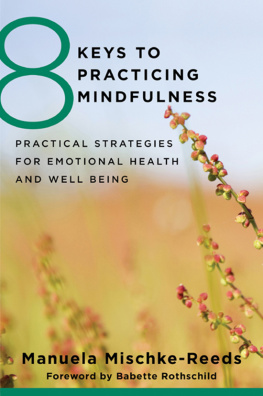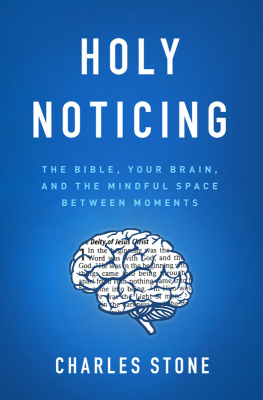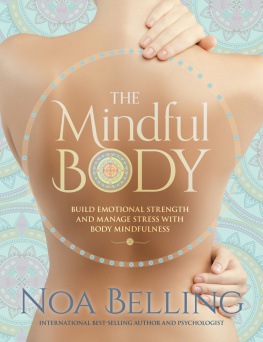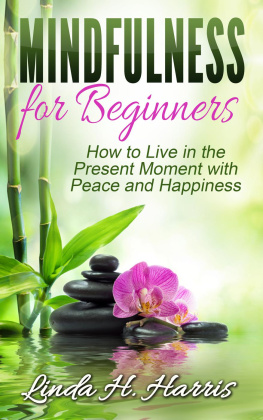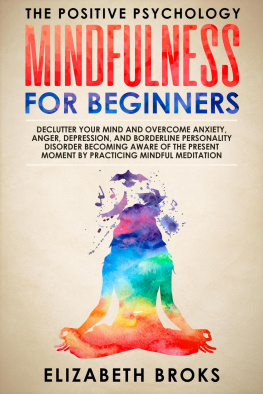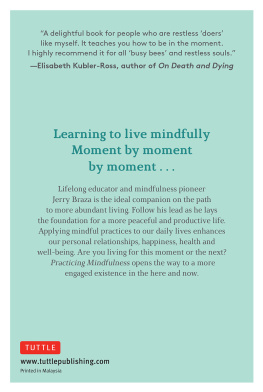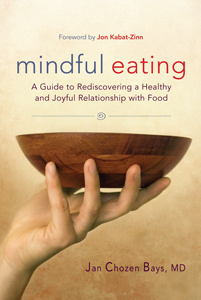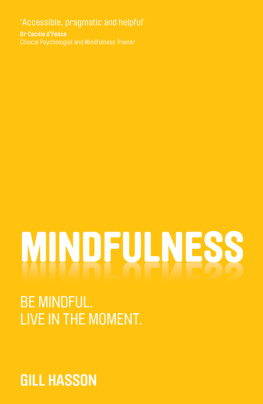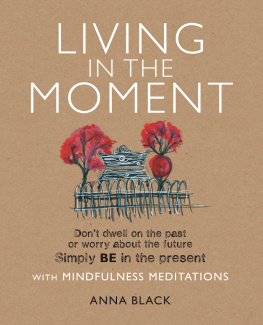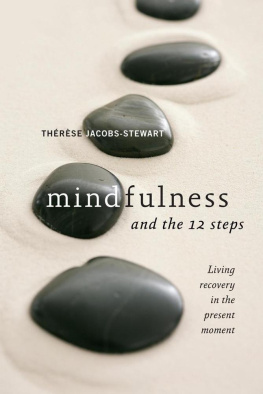
The Three-Part Breathing and Breathing with the Earth in Mind mindfulness exercises are adapted from Reginald A. Ray (Touching Enlightenment. Findings Realization in the Body), pages 367372, 361366. Use with permission by SoundsTrue.
The Heart Practice exercise is adapted from Reginald A. Ray.
Used with permission by Reginald A. Ray.
Copyright 2015 by Manuela Mischke Reeds
All rights reserved
First Edition
For information about permission to reproduce selections from this book, write to
Permissions, W. W. Norton & Company, Inc., 500 Fifth Avenue, New York, NY 10110
For information about special discounts for bulk purchases,
please contact W. W. Norton
Special Sales at specialsales@wwnorton.com or 800-233-4830
Production manager: Leeann Graham
ISBN: 978-0-393-70795-3 (pbk.)
ISBN: 978-0-393-70909-4 (e-book)
W. W. Norton & Company, Inc., 500 Fifth Avenue, New York, N.Y. 10110
www.wwnorton.com
W. W. Norton & Company Ltd., Castle House, 75/76 Wells Street,
London W1T 3QT
For Kirian and Tristan
Also available from the
8 Keys to Mental Health Series
8 Keys to Stress Management
Mark Bowers
8 Keys to Eliminating Passive-Aggressiveness
Andrea Brandt
8 Keys to Forgiveness
Robert Enright
8 Keys to Recovery from an Eating Disorder:
Effective Strategies from Therapeutic Practice and Personal Experience
Carolyn Costin, Gwen Schubert Grabb
8 Keys to Parenting Children with ADHD
Cindy Goldrich
8 Keys to Building Your Best Relationships
Daniel A. Hughes
8 Keys to Old School Parenting Methods for Modern-Day Families
Michael Mascolo
8 Keys to Trauma and Addiction Recovery
Lisa M. Najavits
8 Keys to Safe Trauma Recovery:
Take-Charge Strategies to Empower Your Healing
Babette Rothschild
8 Keys to BrainBody Balance
Robert Scaer
8 Keys to Stress Management
Elizabeth Anne Scott
8 Keys to End Bullying:
Strategies for Parents & Schools
Signe Whitson
8 Keys to Mental Health Series
Babette Rothschild, Series Editor
The 8 Keys series of books provides consumers with brief, inexpensive, and high-quality self-help books on a variety of topics in mental health. Each volume is written by an expert in the field, someone who is capable of presenting evidence-based information in a concise and clear way. These books stand out by offering consumers cutting-edge, relevant theory in easily digestible portions, written in an accessible style. The tone is respectful of the reader and the messages are immediately applicable. Filled with exercises and practical strategies, these books empower readers to help themselves.
A book project like this is a labor of love. From writing it to receiving input and testing the ideas on students and clients, I have been part of an interconnected chain of aware people who care greatly how we live in our bodies and minds.
I am grateful to Babette Rothschild for being a visionary in the field of body-mind psychology and giving me this incredible opportunity. Thank you to Deborah Malmud for supporting this project. A very special thanks to Stephanie Baker, whom I truly could have not done without. Her feedback and keen editors eye have been invaluable. A special thanks to my husband, Michael Mischke Reeds, for his advice and kind words of encouragement. Many thanks to Betsy Burdock and John Perrin for feedback and cheerleading. Thank you to Marylyn Genovese for her research help. A heartfelt thanks to all my amazing clients and loyal students, who have inspired me with their quest for an embodied life; thank you for letting me test the many exercises in this book. A big thank-you to my sons, Kirian and Tristan, who let their mom write even when it wasnt fun to be without her. Because they take mindfulness for granted already, I know there is hope for the next generation to live embodied and emotionally balanced lives. A deep bow to Monika Mischke-Renner, my first and most impactful teacher of compassion and kindness. Deep gratitude to my meditation teachers at Naropa University for inspiring and guiding me as a young student in the teachings of Chgyam Trungpa. Finally, a special thank-you to Reggie Ray, my meditation teacher. You have inspired me to trust my heart and bodynot just with words but with your fierce compassion.
8 KEYS TO
PRACTICING
MINDFULNESS
MANUELA MISCHKE REEDS
FOREWORD BY BABETTE ROTHSCHILD

W. W. Norton & Company
New York London
Your true home is in the here and the now.
THICH NHAT HANH
Y oung children have a remarkable capacity to be absorbed in the details of a moment with curiosity and wonder and without self-awareness or criticism. They may spend long minutes examining the shape of a bugs antennae, marveling at the color of a butterflys wing, or tracing the pattern of raindrops dripping down a windowpane. They possess an intense curiosity for whatever is happening this very second, without judgment. As an adult, you are fully capable of being as open and aware as a child. Yet you may easily forget that you have this ability. The culprit may be speed, worry, anxiety, laziness, emotional patterns, bad habits, or stress. In any case, the simple experience of being present gets lost, and you spend your time anticipating what will be or lamenting what has been. Your daily life is driven by cycles of hope and fear. You dwell in the past or future, but not the present.
Mindfulness can be thought of as a way of being open to what is within and around you. The word mindfulness is the English translation of the ancient Pali word sati, which means awareness and remembering (Bodhi, 2000). Like a curious child, you can look at what surrounds you with no preconceived notions, just an open engagement with whatever is happening now. Although you are an adult, you can remember that this possibility is available to you at any moment.
Most of us need time to connect, to be social and engaged, but we also need time to reflect and retreat. The ebb and flow of engagement and withdrawal is an ancient need of our mammalian bodies and reflects the natural rhythms of our biological system. We move toward excitement to join, belong, and be stimulated. Then we retreat to quiet spaces to lick wounds, heal, reflect, or savor what has happened. We can become sick, disturbed, or disconnected from our own inner wisdom when we dont make the time and space to slow down and find inner peace and balance. Often, when we are in a hurry, we make choices based on efficiency, comfort, or the need for safety. Mindfulness is actually a part of our natural way of being and a way to help us rebalance. When we can access it as a tool, it becomes an inner compass, directing us toward health and sanity.
Mindfulness Versus Meditation
Most people associate meditation with images of a statue of the Buddha or someone praying in a church, synagogue, mosque, or temple. Being mindful is different from meditation. When mindfulness is engaged systematically, we call it meditation. You gain more mindfulness when you practice this way. In this book, the exercises are meditations, but think of them as training wheels for becoming a more mindful person. When you arent engaged in formal meditation, you can practice mindfulness by stopping to wonder at something beautiful or notice a moment of sadness. These moments of awareness are the benefits of formal practice. You gain the ability to shift into a different awareness because you see yourself as you are experiencing emotions and sensations. Formal meditations, such as the exercises in this book, help you fuel and recharge so you can sustain a more balanced emotional life.
Next page
